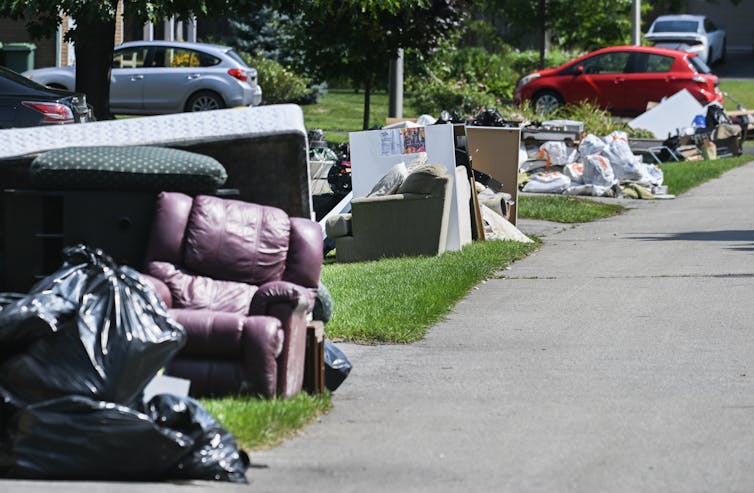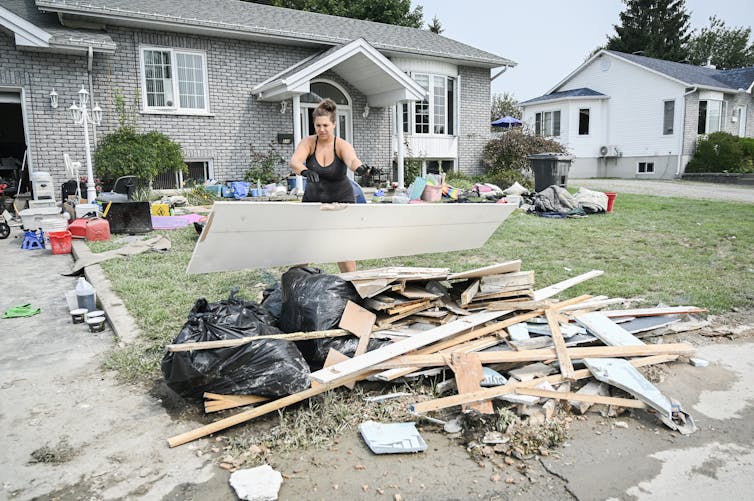Flooding: Is it time to stop living in basements?

Repeated flooding is neither inevitable nor exceptional. Whether it’s the result of a river overflowing, torrential rain or even a failure in the water supply network, flooding has become part of our daily lives.
There are, of course, exceptional events: on Aug. 9, 2024, Montréal and the surrounding area received the heaviest rainfall in more than 100 years following tropical storm Debby. A total of 157 mm of rainfall was recorded at Trudeau airport, and up to 180 mm in the Lanaudière and Laurentians regions. Thousands of basements were flooded. Toronto is also experiencing floods, and its wettest summer season ever, with a record-breaking 128.3 mm of rain at Pearson airport on Aug. 17, 2024.
Every year, taxpayers pay a heavy price for the damage these disasters cause. And that doesn’t take into account the largely overlooked human and social consequences on our communities of flooding.
Every time there is a flooding event, decision-makers talk about the need to review our land use regulation practices or encourage the construction of green and water retention infrastructure. These changes are certainly necessary even if the benefits will only be felt in the distant future. However, the vast majority of citizens exposed to flooding events already live in areas at risk, and these areas already have such infrastructure.
Cars drive slowly through flooded streets in Sainte-Anne-de-Bellevue, on the island of Montréal, after record rainfall hit the region on Aug. 9, 2024.
The Canadian Press/Peter McCabe
Two immediate solutions can reduce the cost of damage and the social consequences of future floods: 1) regulate the use of basements; and 2) replace the principle of rebuilding identically with that of rebuilding better.
As a doctoral candidate in environmental sciences at the Université du Québec à Montréal, my work focuses on Québec municipalities’ contribution to flood risk sharing. Specifically, I oversaw the creation of the Fonds d’assurance des municipalités du Québec, an insurer that specializes in the management and transfer of municipal risks.
From cellars designed to store coal, to basements converted into living environments
In the past, cellars were dark, damp, utilitarian spaces designed to store coal and other provisions. Built from simple materials such as stone, brick or wood, they were often prone to water infiltration. So the idea of living in a cellar was inconceivable.
Today, the purpose of basements has completely changed. They have been transformed into real living spaces equipped with every comfort: game rooms, home theatres, sports rooms, full bathrooms and children’s bedrooms. This development is part of a general trend towards optimizing living space and improving comfort. The use of basements as living spaces has become a particularly popular practice in Québec, but also elsewhere in northeast North America.
However, this development generates new risks, as the recent floods in Québec in August demonstrated. This is why the trend is now to eliminate basements and build on concrete slabs.

Remains of flooded basements of residences in Beaconsfield, west of Montréal, on Aug. 13, 2024, following storm Debby, which occurred on Aug. 9.
The Canadian Press/Graham Hughes
According to the compensation data used to construct the flood-damage curves in Québec to estimate damage to residential buildings, 85 per cent of compensation paid is for damage caused at less than 30 centimetres below ground level, i.e. mainly to basements.
By regulating the use of basements, it would be possible to significantly reduce the cost and consequences of damage. For example, regulations could prohibit the construction of new basements in high-risk areas and regulate types of materials and finishes to be used in low-risk areas. Undertaking work to overhaul the regulations on the use of basements is a societal choice that we should no longer put off.
The principle of identical reconstruction: an aberration in risk management
The principle of identical reconstruction in insurance, which is encoded in Québec government decrees, becomes an aberration when it’s applied to flood risk management. The idea of restoring a property to a condition as close as possible to its initial state before the disaster is counterproductive. It amounts to reproducing the conditions that led to the damage in the first place.
The origins of this principle go back a long way and are linked to the notion of full compensation for loss. The concept evolved from ancient customs and the first insurance contracts ever drawn up. Numerous laws have also introduced specific provisions about identical reconstruction, often in response to key events such as natural disasters and major fires. Courts have also played an important role in clarifying the expression of this principle. However, its formalization and application run counter to the principle of “build back better.”

A woman throws away drywall damaged by floodwaters that inundated her home in Louiseville, Que. on Aug. 15, 2024, nearly a week after storm Debby dumped up to 175 mm of rain in the province.
The Canadian Press/Graham Hughes
This concept of building back better refers to a post-disaster recovery process that leads to buildings and infrastructure which are better adapted to the risk of flooding than those lost during a catastrophic event. The Sendai Framework for Disaster Risk Reduction (2015-2030), which was ratified by Canada in 2015, also emphasizes the need to build back better following a disaster.
It is imperative to adopt this approach, rather than simply rebuilding identically. By incorporating measures to adapt to climate change and flooding, we can strengthen the resilience of our buildings and reduce their vulnerability to future disasters. For example, in Chile, regulations on building standards for earthquake risk are reviewed after each major event and new standards are put in place immediately for new buildings. Old buildings have five years to be brought up to standard. In France, reconstruction standards are also much stricter.

After facing criticism, Québec Premier François Legault visited the municipality of Louiseville, badly affected by the floods, and was greeted by Mayor Yvon Deshaies.
The Canadian Press/Graham Hughes
Towards a multidimensional approach
With the number of extreme weather events on the rise, there is an urgent need to put practical measures in place to reduce the risk of flooding. While regulating the use of basements and the principle of building back better after a disaster are important levers, they will not be enough on their own. Reducing the damage caused by flooding requires a multidimensional approach, combining short-term prevention measures with in-depth action.
The damage caused by flooding is often irreversible. The loss of property, destruction of homes and psychological trauma have a lasting impact on individuals and communities. It is the most vulnerable populations who suffer the most. By taking action, we will be helping to reduce inequalities and ensure a better living environment for all.







